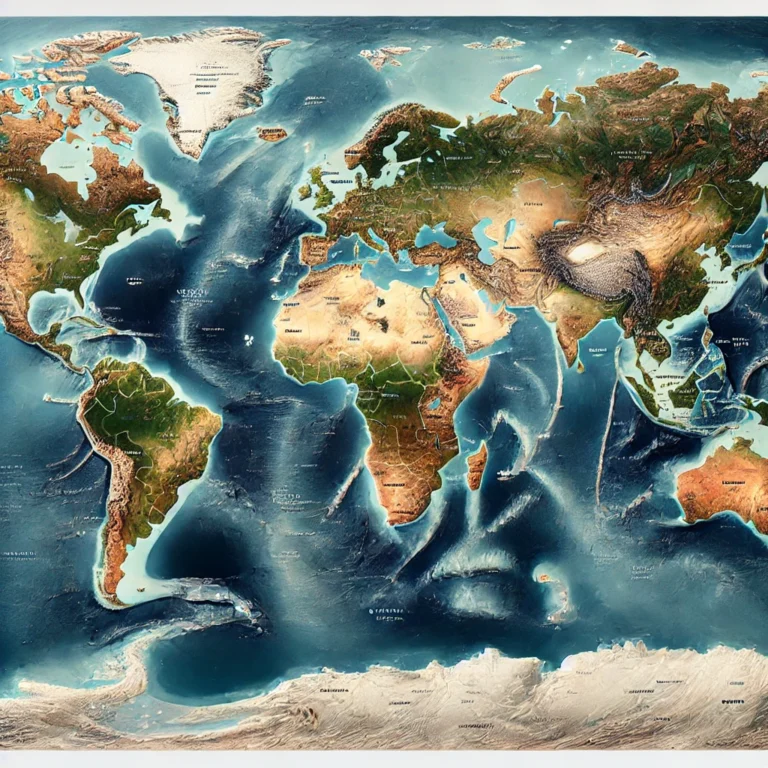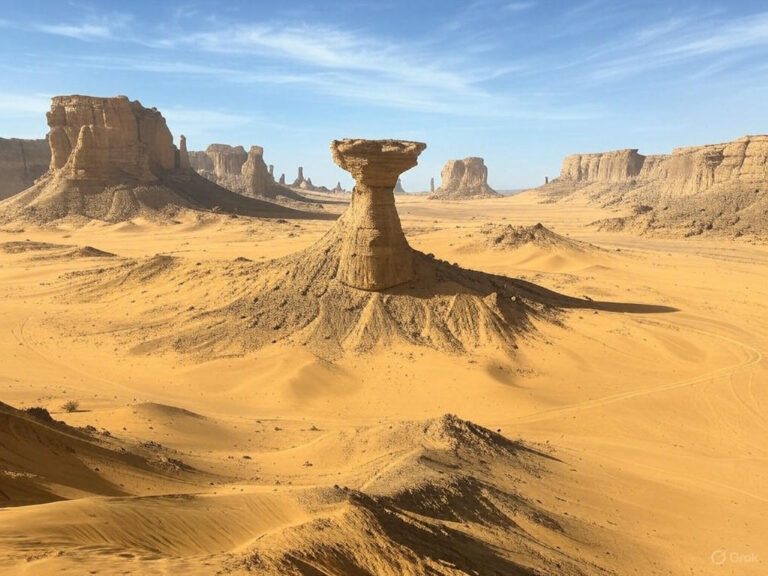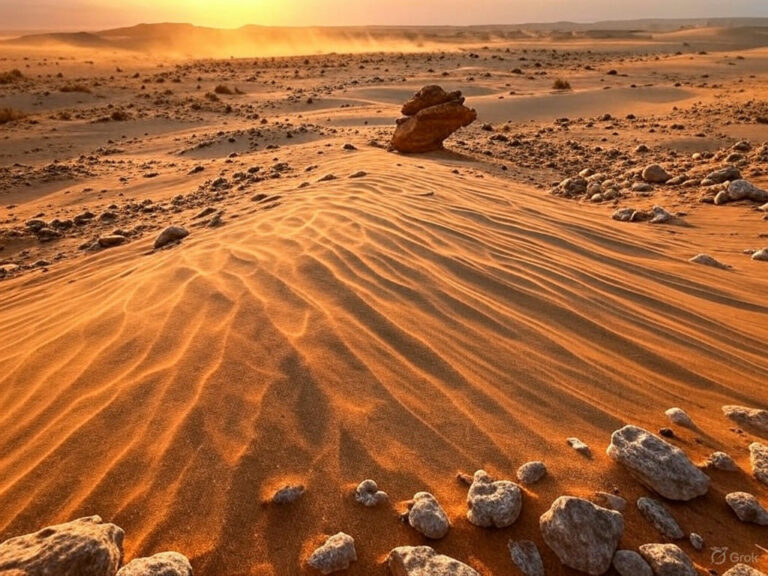Geological Time Scale UPSC
🚀Introduction
The Geological Time Scale (GTS) is like a diary of the Earth, not written in words, but in rocks, fossils, tectonic shifts, and climatic events. It chronicles the transformation of our planet from a molten ball of fire to a life-sustaining home.
But unlike human calendars measured in years, the Earth speaks in millions of years (mya). That’s because real changes on Earth—like the rise of Himalayas or extinction of dinosaurs—take millions of years to unfold.
Here is a simple chart to remember the Geological Time Scale:

📊 Structure of Time Division
The GTS is hierarchically structured from the largest to the smallest unit:
👉 Supereon → Eon → Era → Period → Epoch
The Four Eons of Earth’s History:
- Hadean (4,560–4,000 mya)
- Archean (4,000–2,500 mya)
- Proterozoic (2,500–540 mya)
- Phanerozoic (540 mya–present)
The first three eons (Hadean, Archean, Proterozoic) are collectively called the Precambrian Supereon, covering nearly 88% of Earth’s history.
🌋Hadean Eon (4,560 – 4,000 million years ago)
“This was the time when the Earth was born. But there was no sign of life.”
- Named after Hades, the Greek god of the underworld, because the Earth was a hellish, hostile environment.
- Earth was molten, constantly bombarded by asteroids and meteorites.
- Around 4.5 billion years ago, a planet-sized body named Theia collided with Earth.
🔸 This impact is believed to have created our Moon. - Earth cooled slowly. Volcanic outgassing released CO₂, hydrogen, and water vapour, forming the primordial atmosphere and oceans.
- Oxygen was almost absent.
- Despite high surface temperatures (~230°C), liquid water existed due to high atmospheric pressure (above 27 atm), keeping water in a liquid state. How? Let’s see:
🌡️ Scientific Insight:
Is it possible to boil water at room temperature?
Yes! Lower the pressure, and water boils at a lower temperature.
👉 Boiling point is not just about heat, but also about pressure.
🌊 Archean Eon (4,000 – 2,500 million years ago)
This was the time when the Earth was cooling. The spark of life shone for the very first time.
- First life forms emerged: Prokaryotes (single-celled organisms without nuclei), such as cyanobacteria, around 3.5 billion years ago.
- Atmosphere: still anoxic (no oxygen), and thicker (10–100 atm pressure).
- Oceans: acidic due to high CO₂ content.
- Earth’s crust stabilized, forming the earliest continents.
- Some of the oldest rocks found today are from this eon—evidence of a solid crust.
- By the end of this eon, plate tectonics may have become active, starting the continental drift processes.
🏔️ Proterozoic Eon (2,500 – 540 million years ago)
This was the time when oxygen arrived, life became complex, and the formation of mountains began.
- Oxygen began to accumulate in the atmosphere through photosynthesis by cyanobacteria → The Great Oxygenation Event.
- Emergence of Eukaryotes (cells with a nucleus).
- Multicellular organisms started appearing—soft-bodied life forms.
- First supercontinents formed, like Rodinia (~1000–750 Mya).
- Tectonic activity intensified—this was the era of modern orogeny (mountain-building).
- Most continental crust of modern Earth was formed during this period.
❄️ Snowball Earth Hypothesis:
- Earth may have experienced global glaciation—oceans and continents possibly completely frozen.
- This event drastically altered sea levels, climate, and evolutionary conditions.
🌍 The Phanerozoic Eon (540 million years ago – Present)
This is the time when life became visible to the eye.
The word Phanerozoic literally means visible life. This is the eon when complex, multicellular life flourished, continents shifted, and Earth became the living world as we know it today.
It covers:
- Almost all major plant and animal evolution
- All fossil records used in geological dating
- Multiple mass extinctions
- Shifting of supercontinents: Pangaea → Laurasia + Gondwana → Modern continents
📊 Structure of Phanerozoic
| Era | Time Frame | Nickname |
| Palaeozoic | 540–250 million years ago | Age of Marine Life / Fishes / Amphibians |
| Mesozoic | 250–66 million years ago | Age of Reptiles (Dinosaurs) |
| Cenozoic | 66 million years ago–present | Age of Mammals |
Let’s explore them one by one:
🐚 Palaeozoic Era (540–250 mya)
Life journeyed from the sea to the land.
This was a time of enormous biological expansion. It saw the evolution of arthropods, fishes, amphibians, and reptiles, and ended with the most severe mass extinction in Earth’s history.
📌 Cambrian Period (540–485 mya) – Cambrian Explosion
- A dramatic diversification of marine life: nearly all major animal phyla evolved.
- Evolution of algae, arthropods (like trilobites).
Cambrian Explosion = Explosion of Life
📌 Ordovician Period (485–440 mya)
- Evolution of primitive fishes, corals, mollusks.
- First arthropods moved onto land – beginning of terrestrial life.
- By end: Gondwana moved toward South Pole → glaciation → drop in sea level.
❌ First Mass Extinction: Ordovician–Silurian Extinction
- Second deadliest in history (~85% marine species extinct)
- Due to glaciation, fall in CO₂, and possibly volcanic weathering of silicate rocks.
📌 Silurian Period (440–415 mya)
- Four major continents:
- Gondwana, Laurentia, Baltica, and Siberia.
- Warm climate, stabilized sea levels, expansion of coral reefs.
- Vascular plants and early land arthropods evolved.
📌 Devonian Period (415–360 mya) – Age of Fishes
- Huge diversification of marine fish (placoderms, lobe-finned fishes).
- Evolution of first amphibians, trees, and seed-bearing plants.
Fishes became top predators, and plants began greening the land.
❌ Second Mass Extinction: Late Devonian Extinction
- ~70% species wiped out.
- Causes: anoxic oceans, sea level changes, volcanism, possibly global cooling.
📌 Carboniferous Period (360–300 mya)
- Named after coal formation from vast tropical swamps.
- Oxygen levels high → giant insects and lush vegetation.
- Evolution of amniotic egg → amphibians could move inland.
- Gondwana glaciated due to proximity to South Pole.
📌 Permian Period (300–250 mya)
- Formation of Pangaea, surrounded by Panthalassa (superocean).
- Harsh climate: Dry interiors, extreme seasons.
- Conifers and reptiles dominated land.
Scutosaurus and gorgonopsids roamed the arid deserts.
❌ Third Mass Extinction: Permian–Triassic Extinction (The Great Dying)
- Most severe extinction ever:
- ~96% marine species
- ~70% land vertebrates
- Only known extinction of insects
- Causes:
- Siberian Traps volcanism (CO₂, methane release)
- Methanogen activity → runaway greenhouse effect
- Possible asteroid impact
So, this ends the Palaeozoic era and we are ready to move on to Mesozoic era:
🦖 Mesozoic Era (250–66 mya) – Age of Reptiles
Dinosaurs rose and fell in this very era.
Continents break apart, dinosaurs dominate, mammals and birds emerge.
📌 Triassic Period (250–200 mya)
- Post-Permian extinction: life slowly recovered
- Pangaea still intact → dry, desert-like interiors.
- Tethys Sea started forming in the Middle Triassic
- By Late Triassic, first true dinosaurs and pterosaurs appeared.
❌ Fourth Mass Extinction: Triassic–Jurassic Extinction
- Elimination of many large amphibians.
- Causes: Volcanism, climate change, acidification, CO₂ or sulfur dioxide release → possible extreme global warming or cooling
🦖 Jurassic Period (200–145 million years ago)
In this era, ancient dinosaurs ruled the Earth.
The Jurassic Period is iconic for the explosive diversification of dinosaurs, early mammals, and true crocodiles.
📚 Three Epochs of Jurassic:
| Epoch | Time Span | Key Events |
| Early Jurassic | 200–175 mya | Crocodiles evolved, large amphibians declined. First true mammals appeared (small, shrew-sized). |
| Middle Jurassic | 175–163 mya | Peak dominance of reptiles; dinosaurs diversified. |
| Late Jurassic | 163–145 mya | Pangaea split into Laurasia (North) and Gondwana (South). |
🦕 Cretaceous Period (145–66 million years ago)
The final chapter of the dinosaurs was written here.
Cretaceous marks the end of dinosaurs and the beginning of mammals’ rise.
📚 Two Epochs:
| Epoch | Time Span | Key Features |
| Early Cretaceous | 145–100 mya | First true birds evolved → competed with pterosaurs. |
| Late Cretaceous | 100–66 mya | First flowering plants and marsupials emerged; Tropical zones shrank due to global cooling. |
❌ Fifth Mass Extinction – Cretaceous–Paleogene (K-Pg or K-T)
- Cause: Massive asteroid impact → Chicxulub crater (Mexico)
- Along with Deccan Traps volcanism poisoning the atmosphere.
- Effect:
- Wiped out all life >10 kg (non-avian dinosaurs).
- ~75% of all species went extinct.
- Aftermath: Rapid adaptive radiation of:
- Mammals (e.g. whales, bats, horses, primates),
- Birds and fish.
So, this completes the discussion of Mesozoic era and we are ready to move to Cenozoic Era:
🐘 Cenozoic Era (66 mya – Present): Age of Mammals
The story of human society begins in this era.
Post-dinosaur extinction, mammals rose and dominated every ecological niche.
📍 Paleogene Period (66–23 mya)
📚 Three Epochs:
| Epoch | Time Span | Key Events |
| Paleocene | 66–56 mya | Continents took modern shape; no Panama yet. General warming → jungles to poles. Mammals small, reptiles like giant crocodiles dominated. |
| Eocene | 56–33 mya | Mammals grew in size (e.g. early whales). Warm, humid climate. |
| Oligocene | 33–23 mya | Grasslands spread, evolution of elephants, cats, dogs. Largest land mammal ever—Paraceratherium evolved. |
📍 Neogene Period (23.03–2.58 mya)
| Epoch | Time Span | Key Features |
| Miocene | 23–5.3 mya | → Closure of Tethys Sea, creation of Arabian Peninsula, led to new inland seas (Black, Caspian, Red). Increased aridity. |
| Pliocene | 5.3–2.58 mya | → Formation of Isthmus of Panama; animals migrated across Americas. → Evolution of Australopithecus – the first human ancestor. → Spread of savannas, rise of Indian monsoon, Sahara desert begins forming. |
❄️ Quaternary Period (2.58 mya – Present)
This is the time of the rise of humankind.
This is the period of glaciation, Homo sapiens, and civilization.
📚 Two Epochs:
| Epoch | Time Span | Key Features |
| Pleistocene | 2.58 mya – 11,700 years ago | Ice Ages, deserts in Africa (Sahara, Namib, Kalahari). |
→ Evolution of mammoths, dire wolves, Homo sapiens, Neanderthals.
→ Ended with extinction of many megafauna
| Epoch | Time Span | Key Features |
| Holocene | 11,700 years ago – Present | Entire recorded human history lies here. |
→ Agriculture, civilizations, religions, technology.
→ Anthropogenic extinction due to human activity = Sixth Mass Extinction (ongoing).
Note: The Meghalayan Age (starting ~2200 BCE) is the most recent officially defined geological age, recognized by the ICS and supported by evidence from Mawmluh Cave, Meghalaya, making it India’s contribution to the global geologic time scale.
🧠 Concept Recap – Six Mass Extinctions:
| Mass Extinction | Era/Period Affected | Cause |
|---|---|---|
| 1️⃣ Ordovician–Silurian | Marine life | Glaciation, sea level drop |
| 2️⃣ Late Devonian | Marine/Amphibians | Ocean anoxia, cooling |
| 3️⃣ Permian–Triassic | 96% life extinct | Siberian Traps, methane release |
| 4️⃣ Triassic–Jurassic | Reptiles/Amphibians | CO₂, acidification |
| 5️⃣ Cretaceous–Paleogene | Dinosaurs | Asteroid + volcanism |
| 6️⃣ Holocene (ongoing) | Mammals, birds | Human activity, habitat loss |
🔑 Evolution Highlights:
- Cambrian Explosion → Multicellular marine life
- Devonian → Amphibians
- Carboniferous → Coal & reptiles
- Cretaceous → Flowering plants & birds
- Pliocene → Human ancestors
- Holocene → Human civilizations
🧮 Consolidated Summary:
| Eon | Era | Period | Epochs (if any) | Time Frame (mya) | Key Features | Mass Extinctions |
|---|---|---|---|---|---|---|
| Precambrian | – | – | – | 4560–540 | Formation of Earth, origin of life, prokaryotes & eukaryotes, oxygenation, Snowball Earth | – |
| → Hadean | – | – | – | 4560–4000 | Earth forms, no rock record, molten surface, Moon formed | – |
| → Archean | – | – | – | 4000–2500 | First life (prokaryotes), early oceans, continents form | – |
| →Proterozoic | – | – | – | 2500–540 | Oxygen increase, eukaryotes, multicellular life, Rodinia, first glaciations | – |
| Phanerozoic | Paleozoic | Cambrian | – | 540–485 | Cambrian explosion, all marine phyla evolve | – |
| Ordovician | – | 485–440 | Primitive fish, corals, land arthropods, Gondwana glaciation | 1st: Ordovician–Silurian | ||
| Silurian | – | 440–415 | First vascular plants, early terrestrial ecosystems | – | ||
| Devonian | – | 415–360 | Age of fishes, first amphibians, first trees | 2nd: Late Devonian | ||
| Carboniferous | – | 360-300 | Coal-forming forests, giant insects, amniotic egg evolution | – | ||
| Permian | – | 300–250 | Supercontinent Pangaea, reptiles dominate, dry interior climate | 3rd: Permian–Triassic (Great Dying) | ||
| Mesozoic | Triassic | Early, Middle, Late | 250–200 | First dinosaurs, pterosaurs, breakup of Pangaea begins | 4th: Triassic–Jurassic | |
| Jurassic | Early, Middle, Late | 200–145 | Peak of dinosaurs, first mammals & crocodiles, Pangaea splits | Jurassic–Cretaceous (minor) | ||
| Cretaceous | Early, Late | 145–66 | First birds, flowering plants, marsupials | 5th: Cretaceous–Paleogene (K-Pg) | ||
| Cenozoic | Paleogene | Paleocene, Eocene, Oligocene | 66–23 | Mammals diversify, continents drift to modern positions | – | |
| Neogene | Miocene, Pliocene | 23–2.58 | Grasslands expand, Australopithecus evolves, Isthmus of Panama forms | – | ||
| Quaternary | Pleistocene, Holocene | 2.58–present | Ice Ages, Homo sapiens, recorded history, Sixth extinction (ongoing due to humans) | 6th (ongoing, Anthropogenic) |





7 Comments